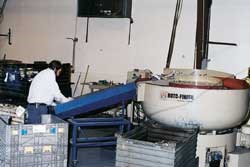Black Oxide Boosts Business
Premier Finishing is growing fast using a traditional customer service approach...
#management
Premier Finishing (Walker, MI) may be only 3 years old, but it is growing fast using an old-fashioned customer service philosophy and state of the art equipment—Premier treats its customers' products as if they are its own. It provides washing, deburring, black oxiding, burnishing, derusting and vibratory finishing. It also provides packaging, shipping and transportation services for its customers.
Andy Ribbens, owner and president, saw a need for these services in western Michigan. He opened the shop with a belt washer that first saw work as a demo model in shows the manufacturer participated in. The washer has an 18-inch wide belt with a 6-inch opening. "Basically, the manufacturer brought it in, took off the wheels and parked it," stated Mr. Ribbens. "I had to have something immediately. It didn't even have any ductwork or conveyor system. I loaded and unloaded the machine manually."
Featured Content
After about a week of this, Mr. Ribbens knew he needed to find a better method. Not only was it taking its toll on him physically, he and the machine could not keep up with production demands. Conveyors and ductwork were added to automate the system, allowing Premier to accomplish in 3-4 hr what used to take 10-12.
Cleaning was not the only process offered at Premier Finishing. The company also offered vibratory finishing. Four vibratory machines from Roto-Finish provide finishes using plastic, ceramic and corncob media. They are used to finish stampings, castings, machined and molded parts.
In the first year or so, the majority of Premier's customers were stampers, particularly those doing work for the automotive industry. When GM had its strike in the summer of 1998, it punched a hole in Premier's business. "When you are a small company and you take about 25% of your revenue away, it really hurts," stated Mr. Ribbens. "That was when we decided we needed to diversify and looked into black oxide."
Black oxide allowed Premier to offer its services to tooling gage shops, machine builders and other shops that were not necessarily automotive related. The company went from a customer base of 10 to 125.
How did Premier find its 115 new customers? It purchased Metal Services Inc., a blackening company in Holland, MI. When it purchased the company, it also purchased its customer list. However, it did not simply inherit all of Metal Services long-established customers. Premier also did mass mailings and made many telephone calls in order to get its name out there as the place for blackening in western Michigan.
Although Premier purchased the Holland blackening company, it decided to purchase a new blackening line rather than move and install the old equipment. However, there was a bit of a dilemma, Mr. Ribbens was not familiar with blackening equipment.
He headed south to Indiana to see a blackening line in operation. Still, he was not quite sure what type of equipment Premier needed to satisfy its customers' needs. Fortunately, his black oxide chemical supplier, Heatbath, volunteered to help.
The new hot black oxide line features 4-ft-deep, 5×4-ft tanks. However, tank size has not kept Premier from black oxiding parts as large as 8-ft long. Parts can be oxided using baskets, barrels or racks.
The first tank on the black oxide line is a 37-gal cleaning tank. Parts are immersed in the 165-175F cleaner for 5-15 min, as necessary. The cleaner is Uni Kleen 14-B, a heavy-duty alkaline soak cleaner that removes solid dirt, soil, oil, buffing and stamping compounds and grease. Because the synthetic detergents used in compounding the cleaner are not adversely affected in acidic solutions, no scum or oily deposit accumulates in the acid descaling tank. A cold-water rinse in an 830-gal double counterflow tank follows.
The third tank is a hydrochloric acid rust/scale remover operated at room temperature. Parts are immersed in the tank for as long as necessary. This is also followed by a cold-water rinse.
The fifth stage is the Pentrate Ultra black oxide, which is run at 285-290F. The black oxide formula does not contain any explosive or hazardous chlorite or chlorate compounds, is non-poisonous and does not contain any cyanide.
Parts are immersed for 15-40 min, depending on requirements. Black oxide concentration is 6-6.5 lb/gal. Flat parts must be agitated frequently so that all areas of the parts are exposed to the black oxide solution. The tank surface is skimmed regularly at operating temperature. A double counterflow cold-water rinse follows.
The eighth tank is water-soluble Lab Oil 100 that is also used as a rust preventive. It is "dry to the touch" and combines high corrosion resistance with excellent emulsification characteristics and low toxicity. It contains no barium compounds. It accounts for approximately 75% of the post dip finishing at Premier.
Two post-dip finishes make up the remaining 25%. One of these is a room-temperature, wax-based, emulsion-type, corrosion-inhibiting compound of low viscosity that produces a hard, dry, continuous nonvolatile film that improves color and appearance and provides extra corrosion protection. The second finish is a lacquer dip. Laq-Dip is a water-borne acrylic lacquer that provides a corrosion- and scratch-resistant finish. Both the wax and lacquer are applied according to customer specifications.
Whether it is washing, deburring, vibratory finishing or black oxide finishing with a special post treatment, Premier provides it. This customer service commitment is also reflected in the way Mr. Ribbens manages the company. He has been selective when hiring employees, and, because of this, Premier has experienced zero employee turnover. Every employee is entrusted with a key to the company. And, these employees and their commitment to customer service has helped Premier exceed a million dollars in sales annually since it started just 3 years ago.
To learn more visit Heatbath Corp..
RELATED CONTENT
-
ISO 14000: Environmental Management
What is it? What is required? Other companys' experiences...
-
Paint Shop Life Cycle Management
Proper planning can help make your paint operations productive from cradle to grave
-
Dear Valued Supplier
"Dear valued supplier," the letter begins.





















